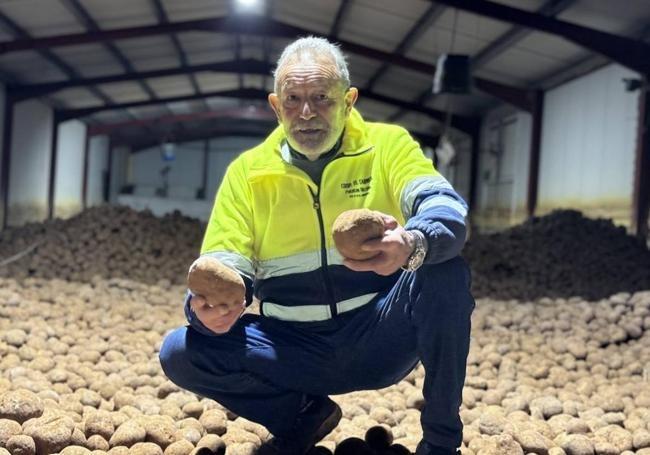Stork's nest in Burgos goes viral: 'From the beginning we wanted to protect it'
A leaning tower is home to three stork's nests on a farm in Arlanza in Burgos in northern Spain. The owner of the estate has tried to stabilise the structure, which has become famous for its unique tilt
Aythami Pérez Miguel
Burgos
Tuesday, 27 May 2025, 11:02
Two adult storks and several stork babies have views over the Castilian countryside in the province of Burgos from their nest. The composition of three nests, one on top of the other, has made this the most shared bird's nest on social media in the province. The 'Castilian Tower of Pisa', according to Burgos influencer Carlo Cuñado.
The nest was widely known by residents of the Arlanza region, near Lerma and Quintanilla del Agua, but social media has boosted its fame. Not only because there are three nests piled on top of each other, weighing more than a tonne, but also because of its perch on a small leaning tower.
It may look like an abandoned building in the middle of a farm, but in fact, it isn't. Behind the viral image hides a story that links this construction, human and animal, with the now deceased businessman José María Ruiz-Mateos, the Nueva Rumasa group, and the 'potato king'.

The potato king
Serna, a farmer from Montorio, received the National Potato Prize awarded by the magazine Revista Campo in 2024. He is now the owner of the farm and the building on which the nests stand. He prevented the structure from collapse by laying a cable and adding concrete to support it.
The building, with the small leaning tower, is located on a farm where Serna now grows potatoes and grain. Potatoes are planted every three or four years due to crop rotation. The building used to house the wiring and electrical system for a pump that drew water from a well, but when Nicolás Serna bought the farm, the well was no longer functional.
-kVuB--748x524@Burgosconecta.jpg)
In 2011, Back in Business formalised the purchase of the Nueva Rumasa group - owned by the Ruiz-Mateos family - in insolvency proceedings. Finally, in 2015, Nicolás Serna bought the estate.
"The land was the European benchmark for the quality of milk its cows produced because they had been crossed with a bull from Canada. There were also pigs, but the animals died here because they weren't fed, they were abandoned," Serna explained.
-
2011: Nueva Rumasa, owner of the estate, had 700 million euros in debt.
-
February 2011: Nueva Rumasa's 10 largest companies applied to insolvency law to avoid imminent suspension of payments.
-
2011: Back in Business formalised the purchase of the Nueva Rumasa group, owned by the Ruiz-Mateos family, in a transaction worth 1.5 billion.
-
2012: Nicolás Serna acquired the rights to the farm. It was a European benchmark for the quality of its cow's milk, but was already in decline.
-
2015: Nicolás Serna bought the farm with the building and the nest, but without its lean.
-
2016: A year of heavy rain caused the ground to give way and with it the structure. The building tilted, but the nest was still there. Cable and concrete were laid to try to stabilise it.
When the farmer from Burgos bought the farm in 2015, the building already existed, as well as the nests. The people of the area say that they have always remembered it there. It is true that it used to be smaller, but the storks have been adding to it every season. It is now an immense structure with three nests and a weight that exceeds a tonne. It's one of the largest stork nests on record.
In 2015 the construction and the nest were already there, but not tilted yet. The myth began in 2016. "That year it rained a lot and clearly it doesn't have a good foundation, so it started to sag. At that point, we decided to put a cable around the tower and anchor it, but it was still leaning, so we poured concrete at the base. It seems to have stabilised, despite its lean, but we don't know how long it will last like this," Serna said.
Protecting storks
The Burgos native's intention was not only to stabilise the building, but protect the nest, to prevent it from falling. "From the beginning we wanted to protect the nest. I really like animals and, besides, they don't do me any harm here," he said. "From the first moment I also notified the environmental service so that it is protected and controlled," he added.
As a man who respects animals, he is now concerned about the increase in visitors to the spot. "I have no objection to people seeing it, but they should do so with a conscience," he explained. Serna asks people to respect the animals, not disturb them and watch from a distance, and also understand that it is a private estate.
"The other day I was playing bowls in the village and a person told me that he had seen someone turn around in the middle of the road to get in, and we also saw a boy who wanted to climb up to the nest," Serna said.
Each season, the storks provide material for their nest, and many return to it. Therefore, year after year, these nests can grow into what we see here in Burgos. In many places, such as churches, you can see how spikes or structures have been put in place to deter storks from building there. SEO/BirdLife recommends installing specific platforms to support the nests and removing material from them when the birds are not nesting.
-k7ZB--1200x840@Burgosconecta.jpg)